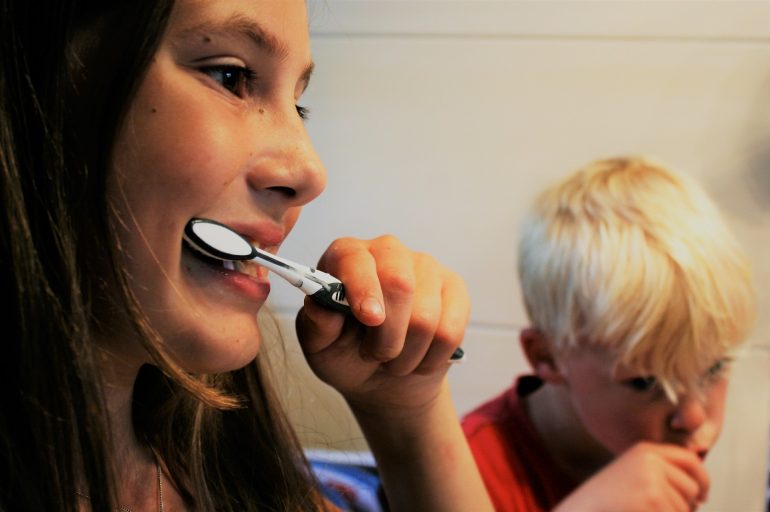Brushing, flossing and dental cleanings are all part of what we do to keep our teeth and gums healthy and strong. It is especially important since so many health conditions are linked to bad teeth and unhealthy gums.
Many scientists believe that the inflammation caused by periodontal disease increases the risk for heart disease. According to dentistryiq.com “This really hits home, in that more than 85 million Americans have some form of cardiovascular disease, while more than 200 million American adults have some form of periodontal disease.
Know what’s in your toothpaste
Many people base the type of toothpaste they buy on how it tastes. In reality it should be based on label ingredients. After reading about some of these commonly added ingredients to toothpaste you might reconsider commercially made toothpastes and start making your own.
Common chemicals found in toothpaste
Polyethylene–Polyethylene is the most commonly used plastic in the world. Used in everything from garbage containers, grocery bags, plastic bottles and containers to bulletproof vests and knee replacements. So why is it used? According to Crest, it is used for cosmetic purposes to add color.
Propylene Glycol- Although this ingredient is used in anti-freeze for your car radiator, you can also find it in moisturizers, hand sanitizers, baby products, conditioners, shampoos and toothpaste. MSDS sheets warn users to avoid skin contact, yet it remains in many cosmetics. It is linked to liver abnormalities and kidney damage. In toothpaste it is used as a wetting agent and surfactant.
Sodium fluoride-Is a byproduct of the aluminum industry. It is also used in pesticides and rat poisons. According to the latest national survey by the Centers for Disease Control, 41% of American adolescents now have some form of fluorosis — an increase of over 400% from the rates found 60 years ago. The website fluoridealert.org adds “Before the widespread use of fluoride in dentistry, dental fluorosis was rarely found in western countries. Today, with virtually every toothpaste now containing fluoride, and most U.S. water supplies containing fluoride chemicals, dental fluorosis rates have reached unprecedented levels.”
Sodium Lauryl Sulfate- SLS is a detergent and a surfactant used to break down surface tension allowing the toothpaste to become a more effective cleanser. According to the American College of Toxicology, sodium laurel sulfate may stay within the body for up to five days, accumulating in the heart, liver, lungs and brain. A study in the U.S. National Library of Medicine found that a significantly higher frequency of canker sores in patients who brushed with an SLS-containing toothpaste. SLS is also linked to Nitrosamines a potent carcinogen that causes your body to absorb nitrates, another known carcinogen. Over 40,000 studies in the PubMed science library include information on this chemical.
Triclosan-Is a pesticide registered with the EPA in 1969. It should not be in toothpaste. This chemical is commonly found in numerous anti-bacterial products. Scientists also classify this as a chlorophenol, which is a chemical that is suspected of causing cancer in humans.
Red 30 Dye- Is a synthetic dye produced from petroleum or coal tar sources, approved by the FDA for drugs and cosmetics. The Environmental Working Group (EWG) rates this dye as moderate health hazard.
Blue 1 Lake Dye-The FDA approved Blue #1 for general use in food and ingested drugs in 1969. Blue 1 can induce an allergic response in individuals with pre-existing moderate asthma. The dye can cause hypersensitivity reactions. Blue 1 has been banned in Austria, Belgium, Denmark, France, Germany, Italy, Spain, Sweden and Switzerland. It has been certified as food safe in the EU and is legal in most countries.
Sodium Saccharin- Saccharin is a widely used non –nutritive sweetener in many products, such as table top sweeteners, beverages, mouthwash and toothpaste. Saccharin was discovered by Constantin Fahlberg, who was researching coal tar derivatives, when he discovered saccharin. Saccharin is found in “Sweet ‘n Low”, and other processed foods. Saccharin is in a class of compounds known as sulfonamides, which can cause allergic reactions in some individuals. Reactions can include breathing difficulties, diarrhea, and skin eruptions.
Titanium dioxide-Is an inorganic compound used as a colorant. It gives non-gel toothpastes their bright whiteness. Titanium dioxide has been described as a possible human carcinogen by the Canadian Center for Occupational Health and Safety.
PEG-8 and PEG-12-The term “PEG” (polyethylene glycol) is used for synthetic polymers of ethylene oxide — in toothpaste they are used as a humectants and solvents. Humectants prevent water loss and act as stabilizers. According to Environmental Working Group or EWG, these polymers can be contaminated with potentially toxic manufacturing impurities such as 1,4-dioxane.
Make your own toothpaste
You may be thinking that making your own toothpaste is difficult or time consuming. In fact making your own toothpaste is incredibly easy and costs just pennies. You also have the option of flavoring your toothpaste with any flavor of essential oils of your choice. Here are a couple of easy recipes to get you started:
Peppermint Toothpaste
2 tablespoons Coconut Oil
2 tablespoons Baking Soda
10 drops of Peppermint essential oil
Instructions:
Mix baking soda and coconut oil in a small container, until it forms a paste like consistency. Add several drops of peppermint oil and mix.
Orange Toothpaste
½ C. Coconut Oil
2-3 Tbsp. Baking Soda
1 Tbsp. Xylitol (powder in grinder to create a fine texture)
10 drops of orange essential oil
Melt coconut oil on low heat, stir in baking soda. Add xylitol and essential oils. Once it begins to solidify give it another stir and put in container.








